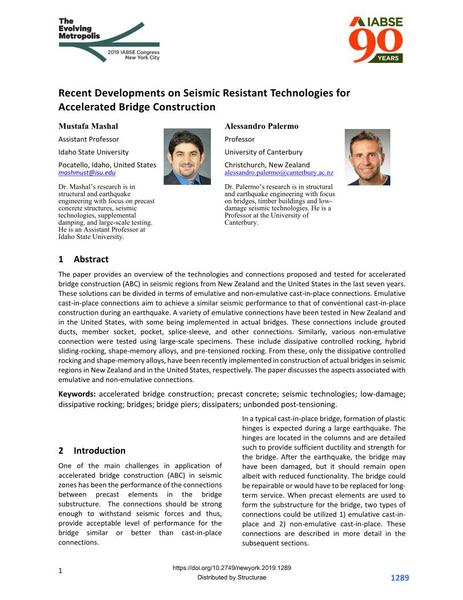Recent Developments on Seismic Resistant Technologies for Accelerated Bridge Construction

|
|
|||||||||||
Détails bibliographiques
| Auteur(s): |
Mustafa Mashal
(Idaho State University)
Alessando Palermo (University of Canterbury) |
||||
|---|---|---|---|---|---|
| Médium: | papier de conférence | ||||
| Langue(s): | anglais | ||||
| Conférence: | IABSE Congress: The Evolving Metropolis, New York, NY, USA, 4-6 September 2019 | ||||
| Publié dans: | The Evolving Metropolis | ||||
|
|||||
| Page(s): | 1289-1297 | ||||
| Nombre total de pages (du PDF): | 9 | ||||
| DOI: | 10.2749/newyork.2019.1289 | ||||
| Abstrait: |
The paper provides an overview of the technologies and connections proposed and tested for accelerated bridge construction (ABC) in seismic regions from New Zealand and the United States in the last seven years. These solutions can be divided in terms of emulative and non‐emulative cast‐in‐place connections. Emulative cast‐in‐place connections aim to achieve a similar seismic performance to that of conventional cast‐in‐place construction during an earthquake. A variety of emulative connections have been tested in New Zealand and in the United States, with some being implemented in actual bridges. These connections include grouted ducts, member socket, pocket, splice‐sleeve, and other connections. Similarly, various non‐emulative connection were tested using large‐scale specimens. These include dissipative controlled rocking, hybrid sliding‐rocking, shape‐memory alloys, and pre‐tensioned rocking. From these, only the dissipative controlled rocking and shape‐memory alloys, have been recently implemented in construction of actual bridges in seismic regions in New Zealand and in the United States, respectively. The paper discusses the aspects associated with emulative and non‐emulative connections. |
||||
| Mots-clé: |
ponts piles de pont
|
||||
